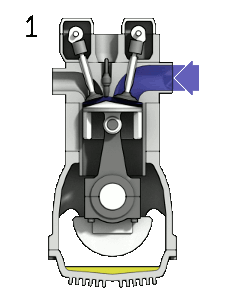Spark plug: Difference between revisions
J.williams (talk | contribs) m (1 revision imported) |
m (1 revision imported) |
||
| (One intermediate revision by one other user not shown) | |||
| Line 1: | Line 1: | ||
[[Category:Done | [[Category:Done 2020-01-31]] | ||
[[File:Spark plugs.jpg|300px|thumbnail|Figure 1. Spark plugs from an internal combustion engine. Note the gap on the left side is where the spark actually ignites the [[gasoline]] and [[air]] mixture.<ref>Wikimedia Commons [Online], Available: http://upload.wikimedia.org/wikipedia/commons/1/10/Spark_plugs.jpg</ref>]] | [[File:Spark plugs.jpg|300px|thumbnail|Figure 1. Spark plugs from an internal combustion engine. Note the gap on the left side is where the spark actually ignites the [[gasoline]] and [[air]] mixture.<ref>Wikimedia Commons [Online], Available: http://upload.wikimedia.org/wikipedia/commons/1/10/Spark_plugs.jpg</ref>]] | ||
<onlyinclude>A '''spark plug''' is used as a source of [[ignition]], as the "spark" in its name | <onlyinclude>A '''spark plug''' is used as a source of [[ignition]], as the "spark" in its name implies. It is a key component of [[internal combustion engine]]s and its primary function is to ignite a fuel/air mixture within the [[combustion]] chamber of a car, or other system.</onlyinclude> Figure 1 shows plugs, the spark travels across the gap on the left side of the spark plug. | ||
The [[voltage]] in the ignition system must be high enough to create a spark across the spark plug gap (see figure 2), much like a bolt of lightning traveling from the clouds to the Earth. These voltages can be anywhere from 40 [[volt|kV]] to 100 kV, in other words ''high voltage''.<ref>HowStuffWorks, ''Spark Plug'' [Online], Available: http://auto.howstuffworks.com/ignition-system2.htm</ref> | The [[voltage]] in the ignition system must be high enough to create a spark across the spark plug gap (see figure 2), much like a bolt of lightning traveling from the clouds to the Earth. These voltages can be anywhere from 40 [[volt|kV]] to 100 kV, in other words ''high voltage''.<ref>HowStuffWorks, ''Spark Plug'' [Online], Available: http://auto.howstuffworks.com/ignition-system2.htm</ref> | ||
Spark plugs are an important part of gasoline engines, but not a part of [[diesel]] engines, since diesel is ignited by the | Spark plugs are an important part of gasoline engines, but not a part of [[diesel]] engines, since diesel is ignited by [[compression ignition]] instead. In figure 2 below note that the timing of when the spark plug fires is very important. The [[combustion]] needs to happen at a precise time, combusting too early (usually because of ignition from compression) leads to [[engine knocking]]. | ||
[[File:4StrokeEngine.gif|framed|center|Figure 2. 4-stroke internal combustion engine. 1:fuel injection, 2:ignition, 3:expansion(work is done), 4:exhaust.<ref>Wikimedia Commons [Online], Available: https://upload.wikimedia.org/wikipedia/commons/d/dc/4StrokeEngine_Ortho_3D_Small.gif</ref>]] | |||
[[ | ==For Further Reading== | ||
*[[Internal combustion engine]] | |||
*[[Gasoline engine]] | |||
*[[Diesel engine]] | |||
*[[Transportation energy use]] | |||
*Or explore a [[Special:Random|random page]] | |||
==References== | ==References== | ||
{{reflist}} | {{reflist}} | ||
[[Category:Uploaded]] | [[Category:Uploaded]] | ||
Latest revision as of 05:10, 31 January 2020
A spark plug is used as a source of ignition, as the "spark" in its name implies. It is a key component of internal combustion engines and its primary function is to ignite a fuel/air mixture within the combustion chamber of a car, or other system. Figure 1 shows plugs, the spark travels across the gap on the left side of the spark plug.
The voltage in the ignition system must be high enough to create a spark across the spark plug gap (see figure 2), much like a bolt of lightning traveling from the clouds to the Earth. These voltages can be anywhere from 40 kV to 100 kV, in other words high voltage.[2]
Spark plugs are an important part of gasoline engines, but not a part of diesel engines, since diesel is ignited by compression ignition instead. In figure 2 below note that the timing of when the spark plug fires is very important. The combustion needs to happen at a precise time, combusting too early (usually because of ignition from compression) leads to engine knocking.

For Further Reading
- Internal combustion engine
- Gasoline engine
- Diesel engine
- Transportation energy use
- Or explore a random page
References
- ↑ Wikimedia Commons [Online], Available: http://upload.wikimedia.org/wikipedia/commons/1/10/Spark_plugs.jpg
- ↑ HowStuffWorks, Spark Plug [Online], Available: http://auto.howstuffworks.com/ignition-system2.htm
- ↑ Wikimedia Commons [Online], Available: https://upload.wikimedia.org/wikipedia/commons/d/dc/4StrokeEngine_Ortho_3D_Small.gif


